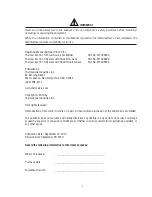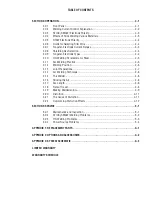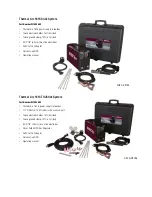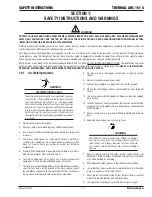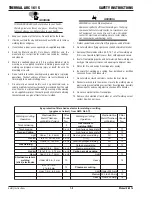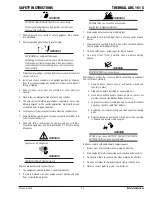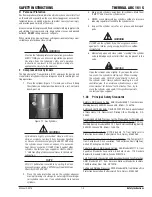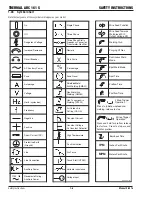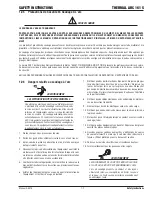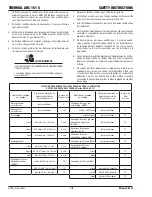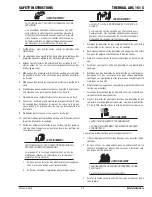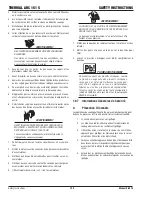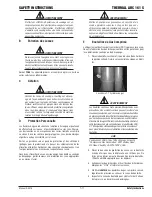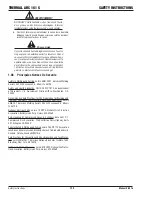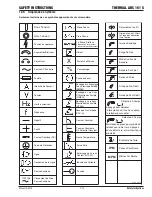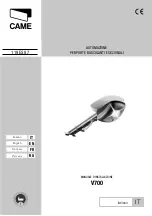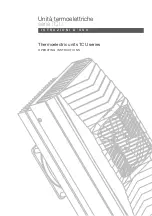
SAFETY INSTRUCTIONS
THERMAL ARC 161 S
Manual 0-5073
1-5
Safety Instructions
Safety Instructions
D Personal Protection
Gas flames produce infrared radiation which may have a harmful effect
on the skin and especially on the eyes. Select goggles or a mask with
tempered lenses, shaded 4 or darker, to protect your eyes from injury
and provide good visibility of the work.
Always wear protective gloves and flame-resistant clothing to protect skin
and clothing from sparks and slag. Keep collars, sleeves, and pockets
buttoned.
DO NOT
roll up sleeves or cuff pants.
When working in a non-welding or cutting environment, always wear
suitable eye protection or face shield.
!
WARNING
Practice the following safety and operation precautions
EVERY TIME you use pressure regulation equipment.
Deviation from the following safety and operation
instructions can result in fire, explosion, damage to
equipment, or injury to the operator.
E Compressed Gas Cylinders
The Department of Transportation (DOT) approves the design and
manufacture of cylinders that contain gases used for welding or cut-
ting operations.
1. Place the cylinder (Figure 1-1) where you will use it. Keep
the cylinder in a vertical position. Secure it to a cart, wall, work
bench, post, etc.
Figure 1-1: Gas Cylinders
!
WARNING
Cylinders are highly pressurized. Handle with care.
Serious accidents can result from improper handling
or misuse of compressed gas cylinders DO NOT drop
the cylinder, knock it over, or expose it to excessive
heat, flames or sparks. DO NOT strike it against other
cylinders. Contact your gas supplier or refer to CGA P-
1 “Safe Handling of Compressed Gases in Containers”
publication.
NOTE
CGA P-1 publication is available by writing the Com-
pressed Gas Association, 4221 Walney Road, 5th Floor,
Chantilly,VA 20151-2923
2. Place the valve protection cap on the cylinder whenever
moving it, placing it in storage, or not using it. Never drag or
roll cylinders in any way. Use a suitable hand truck to move
cylinders.
3. Store empty cylinders away from full cylinders. Mark them
“EMPTY” and close the cylinder valve.
4. NEVER use compressed gas cylinders without a pressure
reducing regulator attached to the cylinder valve.
5. Inspect the cylinder valve for oil, grease, and damaged
parts.
!
WARNING
DO NOT use the cylinder if you find oil, grease or dam-
aged parts. Inform your gas supplier of this condition
immediately.
6. Momentarily open and close (called “cracking”) the cylinder
valve to dislodge any dust or dirt that may be present in the
valve.
CAUTION
Open the cylinder valve slightly. If you open the valve
too much, the cylinder could tip over. When cracking
the cylinder valve, DO NOT stand directly in front of
the cylinder valve. Always perform cracking in a well
ventilated area. If an acetylene cylinder sprays a mist
when cracked, let it stand for 15 minutes. Then, try to
crack the cylinder valve again. If this problem persists,
contact your gas supplier.
1.03 Principal Safety Standards
Safety in Welding and Cutting, ANSI Standard Z49.1, from American
Welding Society, 550 N.W. LeJeune Rd., Miami, FL 33126.
Safety and Health Standards, OSHA 29 CFR 1910, from Superintendent
of Documents, U.S. Government Printing Office, Washington, D.C.
20402.
Recommended Safe Practices for the Preparation for Welding and
Cutting of Containers That Have Held Hazardous Substances, American
Welding Society Standard AWS F4.1, from American Welding Society,
550 N.W. LeJeune Rd., Miami, FL 33126.
National Electrical Code, NFPA Standard 70, from National Fire
Protection Association, Batterymarch Park, Quincy, MA 02269.
Safe Handling of Compressed Gases in Cylinders, CGA Pamphlet P-1,
from Compressed Gas Association, 1235 Jefferson Davis Highway,
Suite 501, Arlington, VA 22202.
Code for Safety in Welding and Cutting, CSA Standard W117.2, from
Canadian Standards Association, Standards Sales, 178 Rexdale
Boulevard, Rexdale, Ontario, Canada M9W 1R3.
Safe Practices for Occupation and Educational Eye and Face Protection,
ANSI Standard Z87.1, from American National Standards Institute,
1430 Broadway, New York, NY 10018.
Cutting and Welding Processes, NFPA Standard 51B, from National Fire
Protection Association, Batterymarch Park, Quincy, MA 02269.
Содержание 161 S
Страница 20: ...This page left blank intentionally ...
Страница 46: ...This Page Intentionally Blank ...



